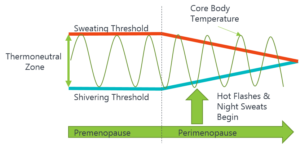A study by Yale University reviewing insurance claims found 75% of women suffering from menopausal symptoms leave their doctors’ offices without answers.1 Why? One reason might be because we need a better understanding of the connection between neurotransmitters and hot flashes.
Controlling the Body’s Core Temperature
Hot flashes and the accompanying sweating and flushing are the result of temperature changes in the body. Therefore, understanding how the body regulates internal temperature is important.
The body’s core temperature (Tc) usually falls in an area known as the thermoneutral zone- not hot, not cold, just right. Hot flashes occur when the body’s Tc extends above the top level of the thermoneutral zone. Likewise, chills often occur when the Tc drops below the lower limit. During perimenopause, the thermoneutral zone narrows resulting in hot flashes and chills. The question is, what causes the zone to narrow?

Neurotransmitters and Hot Flashes: Narrowing the Zone
Research indicates three major influencers of hot flashes:
- Estrogen
- Serotonin
- Norepinephrine (NE)
Interactions between them influence the width of the thermoneutral zone. Understanding how they interact offers insight that may help determine effective solutions.
Estrogen and Serotonin
Decreases in serotonin and estrogen cause narrowing of the thermoneutral zone. This is most likely a result of how estradiol (E2) impacts serotonin levels. E2 positively influences serotonin levels/activity in several ways:
- E2 increases the amount of tryptophan hydroxylase, the enzyme responsible for making serotonin.2
- E2 increases the amount of time serotonin has to bind to receptors by preventing its reuptake. 2
- E2 suppresses monoamine oxidase-A, an enzyme that breaks down serotonin.
- E2 increases the amount of 5HT2A receptors and increases serotonin activity. 2
So, when E2 levels fall in perimenopause, serotonin levels and activity may fall as well, resulting in a narrow zone. Additionally, serotonin from the brain region known as the dorsal raphe has input into the “cooling region” of the hypothalamus.3 Lower serotonin activity from this region may further worsen the situation.
Estrogen and Norepinephrine
While decreases in serotonin may lead to hot flashes, the opposite is true of NE. Increases in central NE cause narrowing of the thermoneutral zone.4
Estrogen modulates adrenergic receptors in the brain. 4 It could be that when estrogen drops, these receptors are no longer inactive. Once active, central levels of NE rise, increasing the chance of a hot flash. 4
Norepinephrine, Serotonin, and GABA
NE and serotonin have complementary but opposite roles beyond their impact on the thermoneutral zone. Norepinephrine is an excitatory neurotransmitter. Its activity is regulated by the inhibitory neurotransmitters serotonin and GABA.
If serotonin and/or GABA levels fall, NE may increase. And, of course…furthering the likelihood a hot flash will occur.
Night Sweats and Sleep
Hot flashes and night sweats often interfere with sleep, but it isn’t just about the heat and discomfort. The neurotransmitters NE, serotonin, and GABA are also major players in sleep. NE disrupts sleep while GABA promotes it. Serotonin’s role is a bit more complex, but healthy levels are needed for a good night’s sleep.
The sex hormones also play a role in sleep. Progesterone supports GABA function while estrogens exert their effects to increase serotonin. Decreases in these hormones during perimenopause along with the changes in neurotransmitter can disrupt sleep.
Achieve that “Just Right” Temperature
Individuals who do not respond to other interventions may want to consider the connection between neurotransmitters and hot flashes. Imbalances in serotonin, norepinephrine, and/or GABA, in addition to hormonal changes, may be present. Neurotransmitter testing can help find imbalances. It can also provide guidance toward the proper intervention for relief from the heat.
Urinary neurotransmitter and salivary hormone testing provide easy-to-use, non-invasive methods of assessing these markers. The HPA-G Complete profile tests both.
Lack of libido is another issue in menopause and andropause. Learn how neurotransmitters affect male libido.
Find a Sanesco provider near you to request the HPA-G Complete profile. Practitioners set up an account or log in to order the profile.
References
- Wolff J. What Doctors Don’t Know About Menopause. AARP The Magazine. 2018 Aug./Sept. Accessed: 2019 Oct. 8. https://www.aarp.org/health/conditions-treatments/info-2018/menopause-symptoms-doctors-relief-treatment.html
- Rybaczyk, LA, et al. (2005). An overlooked connection: serotonergic mediation of estrogen-related physiology and pathology. BMC Women’s Health.
- Weiss D. Why are Women Still Suffering through Menopause? Holistic Primary Care. 2019 Feb 14. Accessed: 2019 Oct. 8 at https://www.holisticprimarycare.net/latest-articles/2026-why-are-women-still-suffering-through-menopause.html
- Freedman RR. J Steroid Biochem Mol Biol. 2014 Jul;142:115-120. Accessed: 2019 Oct. 9. https://www.ncbi.nlm.nih.gov/pmc/articles/PMC4612529/
Updated: 12/10/2019


